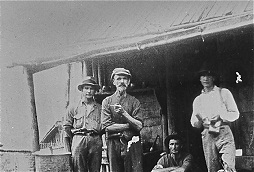An important underlying "theme" of all of our programs is the presentation of  Paluma as a "special place", the scientific and geographical details of what makes it so special, the role of humans within this place over time, and how we preserve special places for the future.
Paluma as a "special place", the scientific and geographical details of what makes it so special, the role of humans within this place over time, and how we preserve special places for the future.
The history of the Mt Spec area is the history of North Queensland in miniature. Several indigenous language groups moved through the forests on the ranges, probably in response to seasonal availability of food sources. The Naiwagi people from the Lower Herbert Valley are today regarded as the traditional owners. We can be reasonably certain that the foot tracks through the forest and the camp clearings used by the first Europeans into the area were theirs.
The first Europeans were miners, who came from the south-west, following tributaries of the Burdekin River from Charters Towers and Ravenswood in search of alluvial gold. Little gold was found around Mt Spec, but alluvial tin was found (in 1875), and used the same simple technologies. Later, at the turn of the twentieth century, tin ore was also mined from hard rock. Other minerals such as silver, copper, lead, iron, molybdite, tungsten, bismuth and manganese and some gemstones (topaz) were found in smaller quantities. Tin-mining continued until the 1980s, when the drop in the world price made it uneconomical.
From the very beginning of European settlement of the ranges, the scenic attractions of the area were noted, as was the cooler climate. Visitors to the area could camp out, or stay at "guesthouses" like Shay's Hut near Mt Spec itself. This theme of a more passive use of the forest winds through Paluma's history.
In the 1920s, the forest as an economic resource was noted, and State Forest 268 was declared in 1928. The rainforest was logged from the 1930s until the 1960s, with the 1988 declaration of the Wet Tropics World Heritage Area preventing the second round of logging due to start in the 1990s. The eucalypt forest to the west is still being logged, but activity is minimal.
The scenic qualities of the rainforest and the difficulties in getting tin and timber down the range were motivations for the construction of the Mt Spec Road as an unemployment relief project in the Great Depression. Clearing started near Ollera Creek in 1930, and the road reached the site of the new township of Paluma in 1935. The stone and concrete arch bridge over Little Crystal Creek reflects recognition of the aesthetics of the area.
In the Second World War, Paluma's location high above Halifax Bay saw the establishment of radar stations, first by the American Army, then the Royal Australian Air Force. The RAAF also had a rehabilitation hospital in the village, requisitioning most of the newly constructed holiday homes. Australia's first "jungle training" was carried out in the nearby rainforest, and a military-style timber camp in the eucalypt forest cut timber for the war effort. The lack of accommodation and petrol rationing meant that visiting Paluma became difficult for those years.
Recreational use of the area resumed in earnest after the War, with private properties handed back in 1946. A small school opened in 1950 in a surplus WAAAF accommodation hut, enrolling the children of local timber cutters. Logging and mining continued, but the economic focus was shifting to education and recreation. Following the closure of the school in 1968, the facility was unofficially used by teachers bringing classes up to study the rainforest. In 1977, the school re-opened as an environmental education centre. A second such centre was established in the former Police Station by James Cook University in 1985 and the Townsville Catholic Education Office opened a third centre in 1994.
Thus, the history of Paluma has come full circle - from the minimal impact of indigenous peoples to the extractive industries of mining and logging, the hiatus to recreational use of the area of the Second World War, to today's focus on education and eco-tourism.
A more detailed history is available for purchase hardcopy from the Centre for a small fee, or can be downloaded free from the Townsville City Council website.